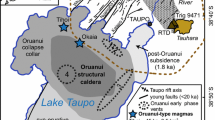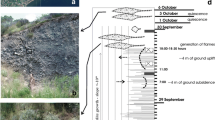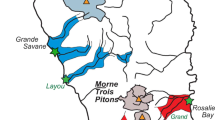Abstract
Rhyolitic pumices in the 26.5 ka Oruanui eruption (Taupo volcano, New Zealand) contain an average of 10 wt% crystals. About 2 wt% of the crystal population is feldspar crystals that display bluish–grey cloudy cores, the colour being imparted by exsolved needles of rutile. The volume of cloudy-cored feldspars thus amounts to ~1.0 km3 in a total magma volume of ~530 km3. The cored feldspars show great variability in detail, but in general have a rounded cloudy core bounded by a zone rich in glass and mineral inclusions, that was then overgrown by a euhedral clear rim. Sr-isotopic variations in eight representative crystals were measured on micromilled samples of selected growth zones in the cores and rims, and linked to feldspar compositions through microprobe traverses. The cloudy cores range from 87Sr/86Sr = 0.70547 to 0.70657, with compositions of An43 to An78. The overgrowth rims display wider variations: inner parts show extreme ranges in composition (maxima 87Sr/86Sr = 0.70764 and An78), while outer parts in seven of eight crystals are zoned, with outward-decreasing Sr-isotopic and An values to figures that are in accord with the bulk pumice and other, clear-feldspar values, respectively. The three parts of the crystals represent distinct regimes. The cloudy cores are inherited from an intermediate plutonic protolith that has been subjected to melting. The inner overgrowth rims were crystallised from a high temperature, relatively radiogenic melt derived from Mesozoic-Palaeozoic metasedimentary rocks (“greywacke”). The outer euhedral rims reflect mixing into and continued growth within the growing Oruanui magma body. The cloudy-cored feldspars also contain rare zircon inclusions. Twenty one zircons were recovered by HF digestion of a bulk sample of cloudy feldspars and analysed by SHRIMP for U–Th isotopes with which to calculate model ages. Eighteen of 21 crystals returned finite ages, the model-age spectrum of which is similar to the age spectra from free zircons in Oruanui pumices. Assembly of the Oruanui magma body was not only rapid (over ~40 kyr, as shown by other data) but involved a wide open system, with significant contributions from partly-melted intermediate-composition igneous intrusions (cloudy cores) and greywacke melts (inner overgrowths) being introduced into the magma body up to the point of eruption. Such open system behaviour contrasts with that proposed in models for comparably voluminous silicic magmas derived dominantly by fractionation (such as the Bishop Tuff) where the magma and its crystal cargo were better insulated thermally and chemically from country-rock interaction.






Similar content being viewed by others
References
Annen C, Sparks RSJ (2002) Effects of repetitive emplacement of basaltic intrusions on thermal evolution and melt generation in the crust. Earth Planet Sci Lett 203:937–955
Annen C, Blundy JD, Sparks RSJ (2006) The genesis of intermediate and silicic magmas in deep crustal hot zones. J Petrol 47:505–539
Bindeman IN, Valley JW (2001) Low-δ18O rhyolites from Yellowstone: magmatic evolution based on analyses of zircons and individual phenocrysts. J Petrol 42:1491–1517
Birck JL (1986) Precision K–Rb–Sr isotopic analysis: application to Rb–Sr chronology. Chem Geol 56:73–83
Blattner P, Reid F (1982) The origin of lavas and ignimbrites of the Taupo Volcanic Zone, New Zealand, in the light of oxygen isotope data. Geochim Cosmochim Acta 46:1417–1429
Brown SJA, Fletcher IR (1999) SHRIMP U-Th dating of the preeruption growth history of zircons from the 340 ka Whakamaru Ignimbrite, New Zealand: evidence for >250 k.y. magma residence times. Geology 27:1035–1038
Brown SJA, Wilson CJN, Cole JW, Wooden J (1998) The Whakamaru group ignimbrites, Taupo Volcanic Zone, New Zealand: evidence for reverse tapping of a zoned silicic magma system. J Volcanol Geotherm Res 84:1–37
Charlier BLA, Zellmer GF (2000) Some remarks on U–Th mineral ages from igneous rocks with prolonged crystallisation histories. Earth Planet Sci Lett 183:457–469
Charlier BLA, Wilson CJN, Lowenstern JB, Blake S, van Calsteren PW, Davidson JP (2005) Magma generation at a large, hyperactive silicic volcano (Taupo, New Zealand) revealed by U/Th and U/Pb systematics in zircons. J Petrol 46:3–32
Charlier BLA, Ginibre C, Morgan D, Nowell G, Pearson DG, Davidson JP, Ottley CJ (2006) Methods for the microsampling and high-precision analysis of strontium and rubidium isotopes at single crystal scale for petrological and geochronological applications. Chem Geol 232:114–133
Charlier BLA, Bachmann O, Davidson JP, Dungan MA, Morgan DJ (2007) The upper crustal evolution of a large silicic magma body: evidence from crystal-scale Rb–Sr isotopic heterogeneities in the Fish Canyon magmatic system. J Petrol 48:1875–1894
Christensen JN, DePaolo DJ (1996) Time scales of large volume silicic magma systems: Sr isotopic systematics of phenocrysts and glass from the Bishop Tuff, Long Valley, California. Contrib Mineral Petrol 113:100–114
Conrad WK, Nicholls IA, Wall VJ (1988) Water-saturated and undersaturated melting of metaluminous and peraluminous crustal compositions at 10 kb: evidence for the origin of silicic magmas in the Taupo Volcanic Zone, New Zealand, and other occurrences. J Petrol 29:765–803
Couch S, Sparks RSJ, Carroll MR (2001) Mineral disequilibrium in lavas explained by convective self-mixing in open magma chambers. Nature 411:1037–1039
Crowley JL, Schoene B, Bowring SA (2007) U–Pb dating of zircon in the Bishop Tuff at the millenial scale. Geology 35:1123–1126
Davidson JP, Tepley FJ (1997) Recharge in volcanic systems; evidence from isotope profiles of phenocrysts. Science 275:826–829
Davidson JP, Morgan DJ, Charlier BLA, Harlou R, Hora JM (2007) Microsampling and isotopic analysis of igneous rocks: implications for the study of magmatic systems. Ann Rev Earth Planet Sci 35:273–311
Davies GR, Halliday AN (1998) Development of the Long Valley rhyolitic magma system: strontium and neodymium isotope evidence from glasses and individual phenocrysts. Geochim Cosmochim Acta 62:3561–3574
Dufek J, Bergantz GW (2005) Lower crustal magma genesis and preservation: a stochastic framework for the evaluation of basalt-crust interaction. J Petrol 46:2167–2195
Eichelberger JC (1978) Andesitic volcanism and crustal evolution. Nature 275:21–27
Ewart A, Stipp JJ (1968) Petrogenesis of the volcanic rocks of the central North Island, New Zealand, as indicated by a study of Sr87/Sr86 ratios, and Sr, Rb, K, U and Th abundances. Geochim Cosmochim Acta 32:699–736
Graham IJ, Blattner P, McCulloch MT (1990) Meta-igneous granulite xenoliths from Mount Ruapehu, New Zealand: fragments of altered oceanic crust? Contrib Mineral Petrol 105:650–661
Graham IJ, Gulson BL, Hedenquist JW, Mizon K (1992) Petrogenesis of late Cenozoic volcanic rocks from the Taupo Volcanic Zone, New Zealand, in the light of new lead isotope data. Geochim Cosmochim Acta 56:2797–2819
Graham IJ, Cole JW, Briggs RM, Gamble JA, Smith IEM (1995) Petrology and petrogenesis of volcanic rocks from the Taupo Volcanic Zone: a review. J Volcanol Geotherm Res 68:59–87
Gualda GA, Anderson AT, Sutton SR (2007) Rapid crystallization of the Bishop magma. Eos Trans AGU 88(52) Fall Meet Suppl Abstract V43C–03
Halliday AN, Fallick AE, Hutchinson J, Hildreth W (1984) A Nd, Sr and O isotopic investigation into the causes of chemical and isotopic zonation in the Bishop Tuff, California. Earth Planet Sci Lett 68:379–391
Harrison A, White RS (2006) Lithospheric structure of an active backarc basin: the Taupo Volcanic Zone, New Zealand. Geophys J Int 167:968–990
Hildreth W (1981) Gradients in silicic magma chambers: implications for lithospheric magmatism. J Geophys Res 86:10153–10192
Hildreth W (2004) Volcanological perspectives on Long Valley, Mammoth Mountain, and Mono Craters: several contiguous but discrete systems. J Volcanol Geotherm Res 136:169–198
Hildreth W, Wilson CJN (2007) Compositional zoning of the Bishop Tuff. J Petrol 49:951–999
Hora JM (2003) Magma differentiation processes at Ngauruhoe volcano, New Zealand: constraints from chemical, isotopic and textural analysis of plagioclase crystal zoning. MSc thesis Univ Calif Los Angeles, pp 200
Houghton BF, Wilson CJN, McWilliams MO, Lanphere MA, Weaver SD, Briggs RM, Pringle MS (1995) Chronology and dynamics of a large silicic magmatic system: central Taupo Volcanic Zone, New Zealand. Geology 23:13–16
Huppert HE, Sparks RSJ (1988) The generation of granitic magmas by intrusion of basalt into continental crust. J Petrol 29:599–624
Kuno H (1936) Petrological notes on some pyroxene andesites from Hakone volcano, with special reference to some types with pigeonite phenocrysts. Jpn J Geol Geogr 13:107–140
Liu Y, Anderson AT, Wilson CJN, Davis AM, Steele IM (2006) Mixing and differentiation in the Oruanui rhyolitic magma, Taupo, New Zealand: evidence from volatiles and trace elements in melt inclusions. Contrib Mineral Petrol 151:71–87
Ludwig KA (2003) Isoplot/Ex version 3.00, A geochronological tool kit for Microsoft Excel. Berkeley, California, Berkeley Geochronology Center Special Publication 4
McCulloch MT, Kyser TK, Woodhead J, Kinsley L (1994) Pb-Sr-Nd-O isotopic constraints on the origin of rhyolites from the Taupo Volcanic Zone of New Zealand: evidence for assimilation followed by fractionation from basalt. Contrib Mineral Petrol 115:303–312
Price RC, Gamble JA, Smith IEM, Stewart RB, Eggins SM, Wright IC (2005) An integrated model for the temporal evolution of andesites and rhyolites and crustal development in New Zealand’s North Island. J Volcanol Geotherm Res 140:1–24
Reid F (1983) Origin of the rhyolitic rocks of the Taupo Volcanic Zone, New Zealand. J Volcanol Geotherm Res 15:315–338
Reid MR, Coath CD (2000) In situ U-Pb ages of zircons from the Bishop Tuff: no evidence for long crystal residence times. Geology 28:443–446
Roser BP, Korsch RJ (1988) Provenance signatures of sandstone-mudstone suites determined using discriminant function analysis of major-element data. Chem Geol 67:119–139
Roser BP, Korsch RJ (1999) Geochemical characterization, evolution and source of a Mesozoic accretionary wedge: the Torlesse terrane, New Zealand. Geol Mag 136:493–512
Simon J, Reid MR (2005) The pace of rhyolite differentiation and storage in an ‘archetypical’ silicic magma system, Long Valley, California. Earth Planet Sci Lett 235:123–140
Simon JI, Reid MR, Young ED (2007) Lead isotopes by LA-MC-ICPMS: tracking the emergence of mantle signatures in an evolving silicic magma system. Geochim Cosmochim Acta 71:2014–2035
Sisson TW, Grove TL (1993) Experimental investigations of the role of H2O in calc-alkaline differentiation and subduction zone magmatism. Contrib Mineral Petrol 113:143–166
Sutton AN (1995) Evolution of a large silicic magma system: Taupo volcanic centre, New Zealand. PhD thesis, The Open University, Milton Keynes, UK
Sutton AN, Blake S, Wilson CJN (1995) An outline geochemistry of rhyolite eruptives from Taupo volcanic centre, New Zealand. J Volcanol Geotherm Res 68:153–175
Sutton AN, Blake S, Wilson CJN, Charlier BLA (2000) Late Quaternary evolution of a hyperactive rhyolite magmatic system: Taupo volcanic centre, New Zealand. J Geol Soc Lond 157:537–552
Tepley FJ, Davidson JP, Clynne MA (1999) Magmatic interactions as recorded in plagioclase phenocrysts of Chaos Crags, Lassen Volcanic Center, California. J Petrol 40:787–806
Tepley FJ, Davidson JP, Tilling RI, Arth JG (2000) Magma mixing, recharge and eruption histories recorded in plagioclase phenocrysts from El Chichón volcano, Mexico. J Petrol 40:1397–1411
Tsuchiyama A (1985) Dissolution kinetics of plagioclase in the melt of the system diopside-albite-anorthite, and origin of dusty plagioclase in andesites. Contrib Mineral Petrol 89:1–16
Wilson CJN (2001) The 26.5 ka Oruanui eruption, New Zealand: an introduction and overview. J Volcanol Geotherm Res 112:133–174
Wilson CJN, Houghton BF, Lloyd EF (1986) Volcanic history and evolution of the Maroa-Taupo area, central North Island. In: Smith IEM (ed) Late Cenozoic Volcanism in New Zealand. Royal Society of New Zealand Bulletin 23: 194–223.
Wilson CJN, Blake S, Charlier BLA, Sutton AN (2006) The 26.5 ka Oruanui eruption, Taupo volcano, New Zealand: development, characteristics and evacuation of a large rhyolitic magma body. J Petrol 47:35–69
Wolff JA, Ramos FC (2003) Pb isotope variations among Bandelier Tuff feldspar: no evidence for a long-lived silicic magma chamber. Geology 31:533–536
Wolff JA, Ramos FC, Davidson JP (1999) Sr isotope disequilibrium during differentiation of the Bandelier Tuff: constraints on the crystallization of a large rhyolitic magma chamber. Geology 27:495–498
Acknowledgments
Geoff Nowell, Graham Pearson and Chris Ottley are thanked for their assistance and encouragement in the Durham isotope lab. Co-workers in the isotope lab were Dan Morgan and Catherine Ginibre and we acknowledge their input with microsampling technique development. George Morris is thanked for his assistance with the electron microprobe analyses conducted at Lausanne, and Nick Mortimer for supplying Taupo area greywacke information from the Petlab database. We thank Joe Wooden and Frank Mazdab also for their help with U-Th dating studies at the USGS-Stanford ion probe facility. This work was supported through a NERC grant awarded to JPD (NER/A/S/2000/01008) and BLAC acknowledges continuing support from a NERC fellowship. CJNW acknowledges support from the Marsden Fund of the Royal Society of New Zealand (grant GNS202 and UOA227). Insightful and helpful comments were provided by Vicki Smith and an anonymous reviewer.
Author information
Authors and Affiliations
Corresponding author
Additional information
Communicated by J. Blundy.
Rights and permissions
About this article
Cite this article
Charlier, B.L.A., Wilson, C.J.N. & Davidson, J.P. Rapid open-system assembly of a large silicic magma body: time-resolved evidence from cored plagioclase crystals in the Oruanui eruption deposits, New Zealand. Contrib Mineral Petrol 156, 799–813 (2008). https://doi.org/10.1007/s00410-008-0316-y
Received:
Accepted:
Published:
Issue Date:
DOI: https://doi.org/10.1007/s00410-008-0316-y




